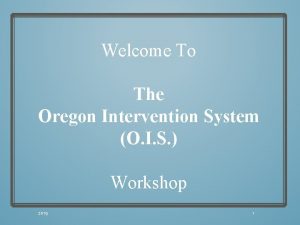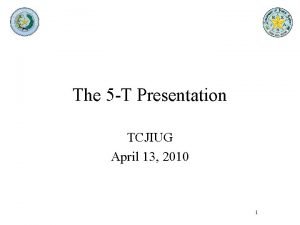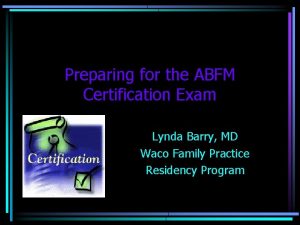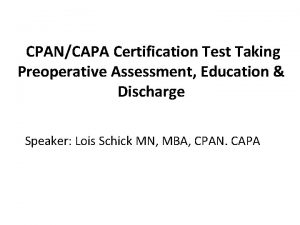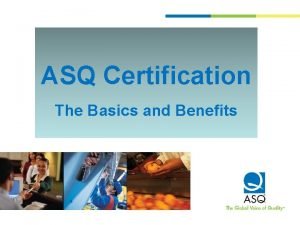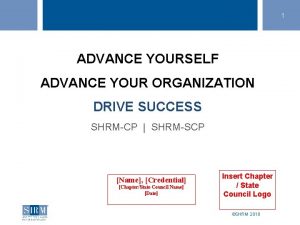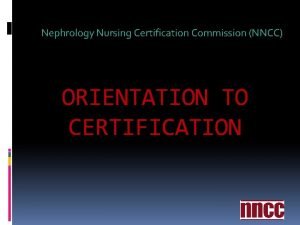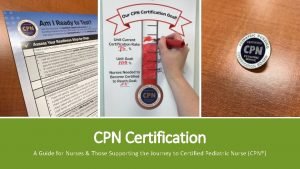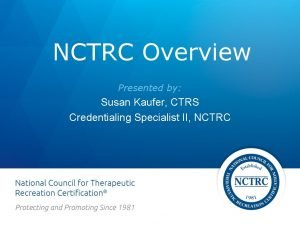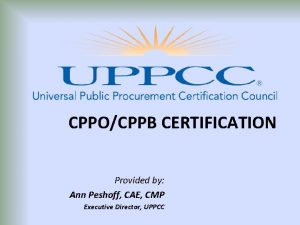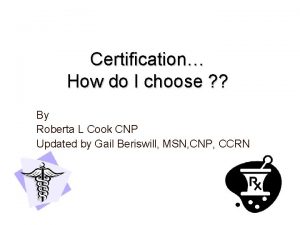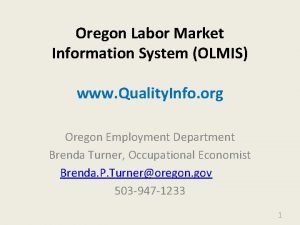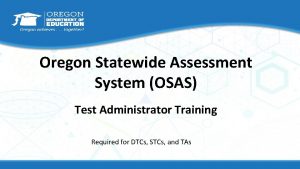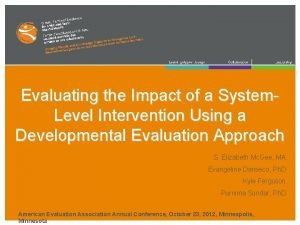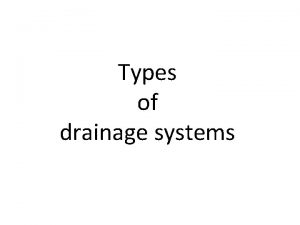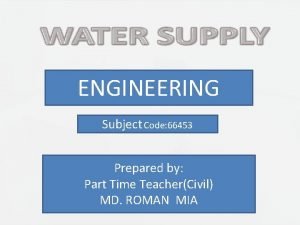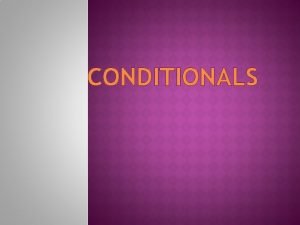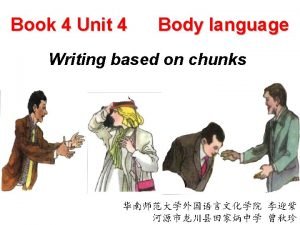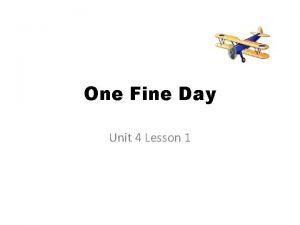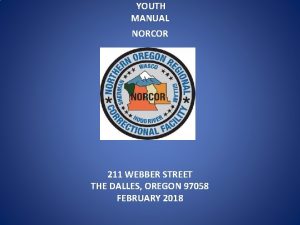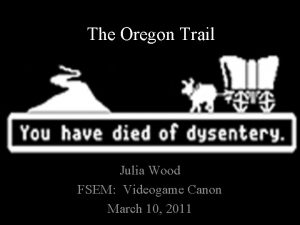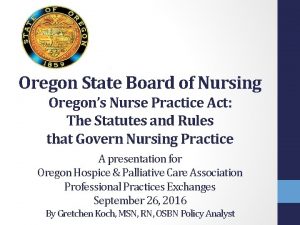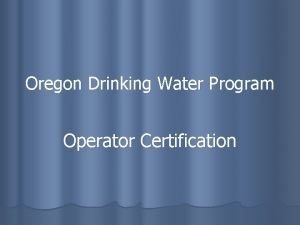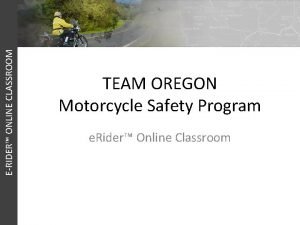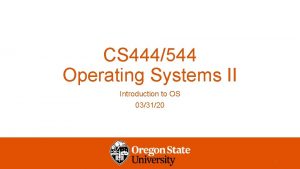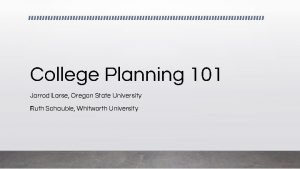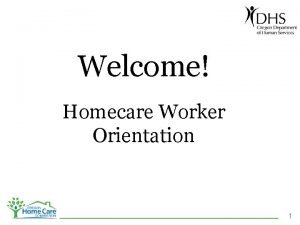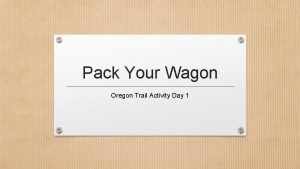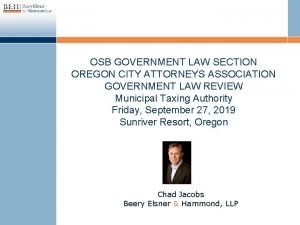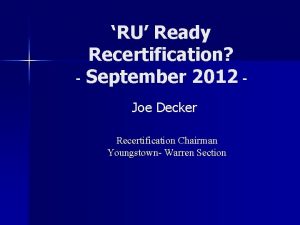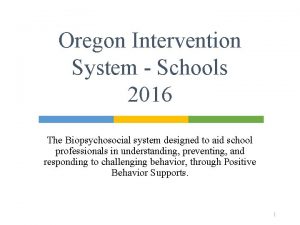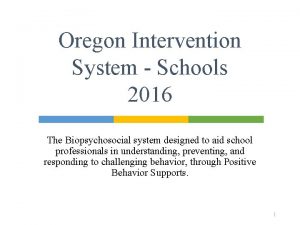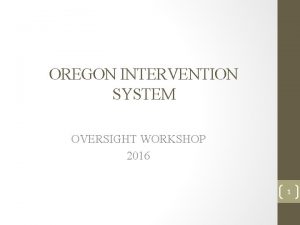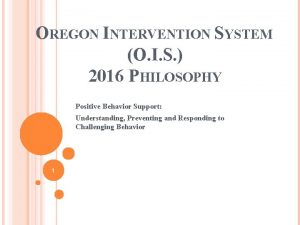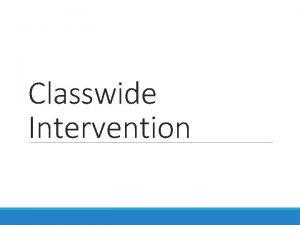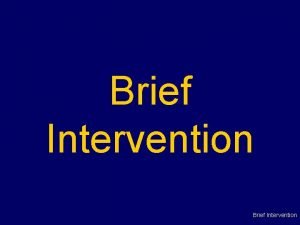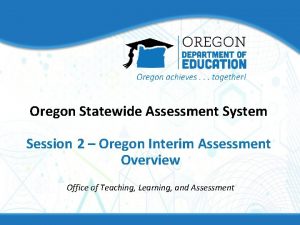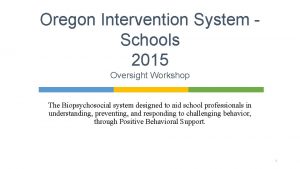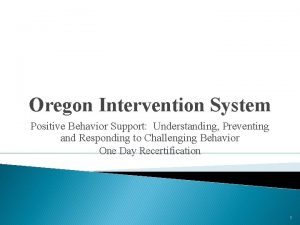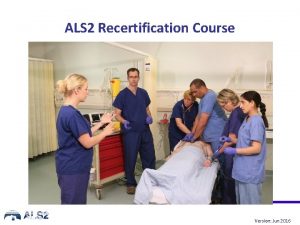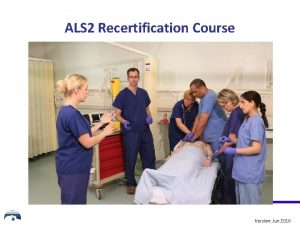Oregon Intervention System 2016 One Day Recertification 1















































































































- Slides: 111

Oregon Intervention System 2016 One Day Recertification 1

Workshop Ground Rules � This is a “G” Level workshop for all participants. � Participants are expected to demonstrate professional behavior within the workshop through. Respecting others, Being considerate, Being on time for class and from breaks, Turning cell phones and pagers off, and Respecting confidentiality! 2

CERTIFICATION REQUIREMENTS � Attend and participate in the entire workshop � Demonstrate a professional attitude in class toward materials & philosophy � Participate in group activities & exercises � Demonstrate an ability to understand safely perform all physical techniques � Complete all written and performance exercises 3

This Workshop will include: ◦ Module 1: Values and OIS ◦ Module 2: Understanding How We Develop ◦ Module 3: Trauma ◦ Module 4: Biopsychosocial Approach to our Behavior ◦ Module 5: Basic Behavior Management ◦ Module 6: Positive Behavior Intervention Support ◦ Module 7: Stress and Self-Control ◦ Module 8: Crisis Management 4

5 OREGON INTERVENTION SYSTEM Module 1 Values and OIS

Values � Values are shaped by our worldview and drive our behavior. � Values guide us when we make choices about what we think is right or wrong. � Values are principles for living that we take seriously enough to practice. 6

Values of OIS � Respecting rights, treating others with dignity, and acknowledging their citizenship. � Person Centered: Behavioral challenges are approached on an individual basis. Although similarities may occur, each behavioral challenge is unique to the person. � Behavioral challenges are complex and require a teambased collaborative decision-making process. 7

Values � What � Who do you believe are the values of OIS? do you believe determines the values of OIS? � Do your personal values fit together with the OIS values? Personal Values Exercise 8

Values of OIS � Challenging behaviors are approached from theoretical framework of Positive Behavioral Intervention Support. � The core principles of OIS emphasize the importance of proactive and preventative strategies rather than reactive strategies. 9

Values of OIS Professional Integrity � To take responsibility for one’s behavior and do what is right when no one is observing. � To not disregard the well being, dignity, or safety of those who depend on our support. � To not misuse the resources of the agency or the consumer. � To honor the directive to be a Mandatory Reporter of abuse and neglect. 10

Integrity Beliefs Actions Words 11

If our actions are congruent with our values then there would be no more. . . 12

13 ABUSE AND NEGLECT

14 Ecological Framework of Abuse/Neglect Potential offender characteristics Potential victim characteristics Cultural context Potential Abuse/Neglect Situation Immediate physical environment

Abuse/Neglect Prevention 15 Have a personal Self-Control Plan Hold your fellow teammates accountable Create a work culture that values the person you support. Manage your stress both at home and at work.

16 What are the potential risk factors in your workplace? Potential Abuse/Neglect Situation

Module Review Topics Covered: • Values of OIS • Personal Values • Personal Integrity • Ecological Frameworks of Abuse/Neglect • Abuse/Neglect Prevention 17

Module 2 Understanding How We Develop Factors Influencing the Development of our Brains (Preset) 18

Challenging Behaviors are a result of thinking (a cognitive process). Therefore, we must understand how our brains develop and work. 19

Understanding How We Develop Common known factors influencing our development: � Environment � Premature Birth � Genetics 20

Understanding How We Develop 21

The Emotional Brain 22

The Emotional Brain and Regulation � The capability to respond, to manage, and maintain daily emotions that may make us feel uncomfortable is difficult for many individuals. � To interpret how our emotions are demonstrated through our actions (behaviors) and perceived by others, then adjust accordingly, takes time to learn. 23

The Emotional Brain and Regulation Five Families of Emotion Regulation Processes SITUATION ATTENTIONAL COGNITIVE RESPONSE SELECTION MODIFICATION DEPLOYMENT CHANGE MODULATION *Seeking out *Changing or a staff to modifying a share my given situation problem *Changing or *Avoiding a modifying the peer who is physical yelling in the environment main area *Pushing all *Not going your dirty to a crowded clothes under super market the bed *This is *Example distraction Playing a *Someone big game- “I yelling and I am not choose to go anxious, I for a walk am pumped outside up to whoop *Remembering their butts” something *”Joe must good that be having a happened to me difficult day as he is yelling really loudly” *Exercise which may decrease the negative emotional response *Deep breathing which will help me get control *Or relaxation exercises 24

Understanding How We Develop � � Emotional Regulation is one component in our development. Our next regulatory system involved in our development is… Executive Functioning 25

Executive Functioning https: //www. youtube. com/watch? v=q. UIr. Wmwg 4 Kg 26

27

28

Class Exercise For those individuals you support, list some areas of difficulty in Executive Functioning or Emotional Regulation that you have observed/encountered. 29

Module Review Ø Our development can be influenced by many factors. Ø Challenging behaviors can be a result of an Executive Functioning deficit and/or Emotional Dysregulation 30

MODULE 3: TRAUMA (Preset) 31

TRAUMA Trauma can be defined as extreme stress that overwhelms a person’s ability to cope. Statistical Fact for People with ID/D: • Over 70% report being victims of abuse- 90% of them said it was on multiple occasions • Only 37% reported the abuse to authorities • 80% of females and 60% of males reported sexual abuse prior to age 21 -Report on Abuse of People with Disabilities, 2013 32

TRAUMA • The brain does not differentiate between physical, emotional, or observatory trauma. All are interpreted by the brain as trauma. (Palay, 2013) • Trauma in childhood can permanently alter neuron response and cognitive pathways in the brain. • Trauma may be associated with abnormal activation of the amygdala, abnormal levels of cortisol, epinephrine, and norepinephrine, and structural changes to the hippocampus. 33

34

TRAUMA • As we know, all of these brain structures and neurochemicals play key roles in regulating our emotional, behavioral, physical, and mental health. • Individuals who have experienced trauma within their lives may respond in one of two ways when a perceived threat presents itself: v Disassociation- detached, numb, compliant, mini-psychoses v Hyperarousal- anxious, reactive, alarm response, hypervigilant 35

TRAUMA • The impact of different traumatic events is not independent of each other; in other words, the events build upon one another, and the stress from the trauma becomes cumulative. • The ability to process traumatic experiences decreases with repeated exposure. This decrease may then express itself through behavioral or mental health disorders. 36

Module 4 37

The Biopsychosocial Approach 38 �This approach encourages consideration of these systems when as they are the “presets” to possible challenging behavior: Ø Biological (that is, physical health/ill health and mental health disorders) Ø Psychological (that is, learning, coping, thoughts) Ø Sociological (that is, environments and relationships) (Engel, 1979)

Class Exercise 39 Develop a list in each of the following categories: Biological Psychological Sociological

A Few Mental Health Disorders We must recognize that it is possible for an individual with intellectual/developmental disability to� Display a challenging behavior, such as aggression, in the absence of a mental health disorder; � Display a diagnosable mental health disorder in the absence of any significant challenging behavior; and, � Have a mental health disorder and a challenging behavior coexist and exert mutual influence over each other. (Allen, 2008) 40

Mental Health Disorders 41 Exercise: List the Following for Area of Work Mental Health Issue Behavioral Symptom

Psychological Biological I Am so I Do Sociological 42

Module Review 43 �The Biopsychosocial theoretical approach assists in identifying the “Presets” that we bring with us when attempting to understand our behavior. �The first hypothesis needs to consider our physical health (biological) first when attempting discussing behavior.

44 Module 5 Basic Behavior Management

It is always easier – and usually far more effective – to focus on changing your behavior than on changing the behavior of others. –Bob Nelson 45

Levels of Supervision » Routine » Close » Constant 46

Environment » The environment has a substantial impact on behavior. » Assessing how we can modify the environment may have an immediate and positive effect on behavior. 47

Appearance and Dress » » » How do we dress? Safe, modest & comfortable Leave items home if they interfere What does grooming say about us? Awareness of our scents & smells Individual considerations 48

Basic Needs/Drives Self-Actualization Helping Others Job Future Working to Life Goal Belonging Love Respect Meeting Social Needs Safe Food Safe Touch Secure Shelter Have Stuff Safety & Predictability Needs Food Shelter Clothing Water Human Touch Survival Needs Legal Substances Illegal Substances Addictive Needs 49

Routines and Rhythms § Having routines and rhythms of our day, week, month, and year is an important aspect of environment. § Routines and rhythms can decrease anxiety and stress. § Everyone relies on routines to a certain degree. Routine activities and rhythm enable us to function effectively and comfortably. § Discussion: How do we disrupt routines for the people we support? 50

Power Struggles » What are some Power Struggles that you have engaged in or witnessed? » How were they resolved? » Was there a winner and a loser? 51

Three Factors to Power Struggles Type • Power over • Personal Power Escalation Spiral • Discussion/ Problem solving • Agitation • Intimidation • Violence Sense of Self • Preserving or enhancing our personal power 52

Who Engages in Power Struggles? » Anyone! Everyone engages in a power struggle at some point. » However, the following staff tend to engage in power struggles most often: • “Perfectionists” • Those with “unrealistic expectations” • “Inexperienced” staff 53

Behaviors that may Contribute to Power Struggles » Arguing » Demanding » Being disrespectful (based upon the person’s perception) » Being inflexible » Being controlling vs. offering choices 54

Minimizing the Power Struggle » Choose your battles » Walk away » Consider the volume of your voice » Set limits, avoid ultimatums » Keep your cool 55

Resolving Power Struggles » Power struggles tend to escalate as they cause both parties to become stressed. » It is not always easy to stop the escalation » Recognizing that you are in a power struggle is the first step. » Then, you must choose a resolution strategy: Power-based, rights-based, or interest-based. 56

De-escalation Tool: Silence » Remaining silent can be powerful. 1. It allows for time to listen to the escalated person and assess the situation. 2. Silence does not add fuel to the fire. If there is nothing to argue with, then the power struggle does not exist. As with any tool, this may not work in all situations. Your continual assessment of the situation will help you decide if it is working. 57

58 Module 6 Positive Behavior Intervention Support

59 Behavior What is a Challenging Behavior? “A behavior can be describe as challenging when it is of such an intensity, frequency or duration as to threaten the quality of life and/or the physical safety of the individual or others and is likely to lead to responses that are restrictive, aversive or result in exclusion” (Emerson, 2001)

Class Exercise Presets Internal/ External Setting Events Antecedents Behavior Consequence 60

61 It’s important to find a replacement behavior that meets the same needs for the individual in a more acceptable or appropriate way. If YOU can’t think of an alternative to difficult behaviors, chances are good the person will have trouble learning one! -David Pitonyak

62 Reinforcement vs. Punishment Reinforcement is the best practice and most effective way to alter challenging behavior Utilizing punishment is the least effective.

63 Punishment • Effective in the presence of the punisher. Increase covertness. • Requires greater resources to be effective. Increasing severity, constant vigilance • Produces unintended consequences: Damages relationships, anger & aggression, changes worldview. • You get more of what you pay attention to!

64 Punishment N ME SH NI PU T

Three Theories for Consideration in Behavior Management • Relationship Model • Trauma Model • Quality of Life Model 65

Relationships (or lack of) “Loneliness may be the number one cause of challenging behavior. ” -David Pitonyak 66

Relationships • Many of the people we support have few relationships outside of family or paid providers. • Often this lack of true friendships causes unhappiness which sometimes manifests itself as “challenging behaviors”. 67

Building Rapport • • Why is building rapport an important part of our daily supports? What are some ways to build rapport with. . . -Someone who doesn’t talk? -Someone who has limited interests? -What about with a person you don’t like? 68

Enhance Community Friendships and Relationships • What is important about building friendships and relationships outside of paid providers? • What role do we play in helping individuals build these relationships? 69

70 Trauma Model “Trauma is any experience or series of experiences that make the individual feel that he or she is in danger of dying, or of being emotionally ‘wiped out’ or annihilated. ” (Palay, 2013)

Trauma Behavioral Pyramid 71 Trauma Behavioral Issues Deeper Emotions Expressed Often rooted in past Behavior trauma Emotion Dysregulation al ic Phys Trauma Observatory Em otio nal (Harvey, 2013)

TRAUMA MODEL For Recovery 72 Perceived Safety Empowerment Connection

Quality of Life Model 73

Quality of Life The quality of one’s life may be conceptualized as sharing these three common themes: v Opportunities to achieve personal potential v Feelings of positive social involvement v General feelings of well-being (Schalock, Brown, et. al, 2002) 74

Social Inclusion Emotional Well-Being TRUE RELAXATION COMMUNITY INCLUSION QUALITY Of Personal Development Rights Self-Determination 75 PERSONAL POTENTIAL LIFE Interpersonal Relationships Material Well Being Physical Well Being

Quality of Life Systems Level Individual Qo. L-Related Principle Empowerment Skill Development Involvement Organization Society Strategy *Decision Making, Choice Making, Risk Taking, Goal Setting *Functional training, Enhance practical skills *Integrated employment, inclusion in the community, education Safe & Secure *Safety, security, predictability, personal control Supports Alignment * Align individualized supports to personal goals Accessibility *Ensuring human rights Attitudes *Knowledge & positive attitudes 76

Chapter Review Ø Ø Ø Ø Discussed what is challenging behavior Setting Events Antecedents Punishment Relationships Trauma Quality of Life 77

78 MODULE 7 STRESS AND SELF-CONTROL

Stress Management 79 • • • This profession is stressful! It is important to proactively and reactively manage your stress. Our support of the consumer is limited by our stress level. Stress can be managed with activities that require physical and mental energy. Physical exercise Gardening Journaling Meditating Deep Breathing

Stress 80 A feeling that’s created when we react to particular events that have a high probability to affect our lives. It’s the body’s way of rising to the challenge and preparing to meet a tough situation with focus, strength, stamina and heightened alertness.

Stress Response 81 Our brains assess a threat in terms of whether or not we can handle it. We can’t always differentiate between real and perceived threats. You don’t have to be directly involved in the event to experience stress.

Influential Factors 82 Confidence Previous Outcomes Training Beliefs Values Goals Culture Social Norms

Managing a Crisis Situation 83 When a person is engaging in a crisis behavior, the goal is often. . . MAKE IT STOP NOW! Instinctually, humans want to use violence to solve problems. Learning non-violent ways to solve problems takes self-control and resources within our brain (including executive functioning).

Two Brains in One 84 Our brains have several functions. Two are: Thinking brain � Survival brain � Each of these brains have specialized functions that work together, but sometimes those specialized functions are at odds with each other. www. rightresponse. org I must use an OIS deflection Thinking Brain Quick, protect my pretty face, I don’t care how! Survival Brain What your brains are thinking when a fist is coming towards your face

Alarm Reaction 85 An alarm reaction occurs when your safety is threatened. This causes your survival brain to take charge, shutting down your thinking brain. Alarm reactions are NOT useful when responding to a challenging issue!

Alarm Reaction Process 86 • • • Everyone freezes at the first sight of danger. Most of us progress to flight or fight. Some people get stuck in freeze or progress to freeze when hope of survival is diminished. All of these responses shut down the thinking brain.

Physiology of Alarm Reaction How we know its happening 87

Shut down the Alarm Reaction 88 When anyone is faced with a threatening situation, your brain wants to respond with an This when you need to protect the person who is threatening you. Instead, you must Maintain Self-Control.

Developing a Self-Control Plan 89 Mandatory Individual Exercise: � Identify what you may do if the alarm reaction is activated. � Identify potential triggers � Identify physical warning signs � Pay attention to your thinking � List techniques that may help you stay in control during a crisis situation.

Self-control must be developed, practiced, and revised throughout your career and personal development. 90 It is the mechanism that we use to minimize the likelihood that we will have an Alarm Reaction.

Stress Cycle Key Unspoken Stress 10% Crisis Escalatio n 50% ↓ 75% Baseline 80% ↑ 91 Trigger Staff emotions Staff actions Beyond Deescalation De-Escalation Stabilizatio n Post-Crisis Drain

De-escalation May Include: 92 Breathing slows to a more normal rate Muscle tension decreases Facial expressions change Fewer threats or attempts to hurt self or others Responds to verbal cues

MODULE 8 CRISIS MANAGEMENT REASONABLE RESPONSE PPI DEFINITIONS 93

RESPONDING TO ESCALATION • Remember: • The “thinking brain” of all escalated people is turned off • Managing the escalating person means we have to appeal to their survival brain • At this point in the stress cycle the goal is to keep everyone safe! 94

ASSESSING THE SITUATION • Teaching and negotiating during escalation is non-productive • However, a person’s response to your negotiation is a good indication of their escalation. • Their response is feedback for you on how you should respond. 95

POWERS OF OBSERVATIONUSE ALL OF YOUR SENSES: • Changes in frequency, duration, and intensity of behavior • Changes in facial color, expressions, or moods 96

CHOOSING OUR RESPONSE When responding to a person who is trying to injure him/herself or others, match the response to the level of injury threatened. 97

CONCEPT OF REASONABLE RESPONSE • What is reasonable response? • Give examples of when you have used reasonable response? • What things do you consider when choosing your response? 98

What we see. . . Reasonable Response Escalation • Threats • Intimidation • Yelling 1. Maintain Self-control 2. Follow BSP or other Guidelines/Protocols 3. Utilize a Tool as previously outlined. Minor Physical Contact • Likely won’t result in needing medical attention • For example: Pinch, scratch, slap, grab, hit 1. 1, 2, and 3 above. 2. OIS Evasions and Deflections Major Physical Contact • Likely to result in an injury requiring medical attention 1. All of the above 2. Possibly a PPI or 911 99

Despite our best efforts to prevent a crisis through proactive and deescalation strategies… Crises may occur. 100

RESPONDING WITH DIGNITY & RESPECT Dignity - quality or state of being worthy, honored, or esteemed Respect - an act of giving particular attention; high or special regard 101

REMEMBER • Maintain Self-Control • The Person’s Plan • Direct/Simple Communication • Timing/Patience • Stop and Think • Spontaneity 102

PROTECTIVE PHYSICAL INTERVENTION (PPI) Protective Physical Interventions are safety procedures utilized with an individual that assists in keeping the person protected from harming themselves or others through supportive measures, as taught in the Oregon Intervention System. 103

WHEN IS A PPI APPROPRIATE? • We are responding to a very challenging and potentially injurious behavior. • The behavior can be safely controlled with a protective physical intervention. • The intervening people providing support are sufficiently trained and can reasonably expect to achieve safe control. 104

WHEN IS A PPI AUTHORIZED? 1. During an EMERGENCY and/or CRISIS situation 2. As part of a plan to maintain health and safety • PBIS Plan/IEP process • Physician’s order 105

REMEMBER The use of Protective Physical Intervention is our LAST RESORT to PREVENT INJURY to the person we support, others when faced with an IMMEDIATE THREAT. 106

THE USE OF PROTECTIVE PHYSICAL INTERVENTION WITHOUT AUTHORIZATION MAY REPRESENT “WRONGFUL RESTRAINT” AND WILL MOST LIKELY RESULT IN REVIEW. 107

PHYSICAL INTERVENTION GUIDELINES • Is there a protocol/plan for safe intervention? • Talk to/Redirect the person • Allow the individual to save face • Start with least intrusive intervention • Evade and assist others to evade • Who should respond? • Has everyone been trained? 108

DISCLAIMER The processes outlined in the OIS workshop have been proven safe and effective when applied correctly. However, proper implementation is the responsibility of the persons involved. Instruction cannot be substituted for good judgment. 109

All training in OIS techniques must be conducted by an approved and certified OIS instructor. There are no exceptions. 110

PHYSICAL PRACTICE Follow the Standards of Physical Skills Training Manual 111
 Day 1 day 2 day 3 day 4
Day 1 day 2 day 3 day 4 Oregon intervention system
Oregon intervention system Day one day one noodle ss2
Day one day one noodle ss2 Dayone dayone noodles ss2 小時光 肆號麵鋪
Dayone dayone noodles ss2 小時光 肆號麵鋪 Day 1 day 2 day 817
Day 1 day 2 day 817 One day casting crowns
One day casting crowns Cppb recertification requirements
Cppb recertification requirements Tcic/tlets mobile access with cch recertification test
Tcic/tlets mobile access with cch recertification test Abfm study guide
Abfm study guide Palo alto free certification
Palo alto free certification Pre op certification
Pre op certification Cqe recertification
Cqe recertification Shrm recertification handbook
Shrm recertification handbook National nephrology certification organization
National nephrology certification organization Cpn review questions
Cpn review questions Nctrc job analysis
Nctrc job analysis Humana medicare advantage certification
Humana medicare advantage certification Certified occupational hearing conservationist
Certified occupational hearing conservationist Cbic recertification
Cbic recertification Sevp recertification checklist
Sevp recertification checklist Cppb certification
Cppb certification Aanc recertification
Aanc recertification One god one empire one emperor
One god one empire one emperor One one one little dogs run
One one one little dogs run One king one law one faith
One king one law one faith One empire one god one emperor
One empire one god one emperor One ford
One ford See one do one teach one
See one do one teach one One price policy
One price policy Twelfth night speeches
Twelfth night speeches Studiendekanat uni bonn
Studiendekanat uni bonn One vision one identity one community
One vision one identity one community One vision one identity one community
One vision one identity one community One variable data table excel 2016
One variable data table excel 2016 Avs asset verification system
Avs asset verification system Olmis oregon
Olmis oregon Oregon state test portal
Oregon state test portal Early warning intervention and monitoring system
Early warning intervention and monitoring system System-level intervention
System-level intervention William beanes elementary school
William beanes elementary school Ocean apart day after day
Ocean apart day after day Day to day maintenance
Day to day maintenance As your room gets messier day by day, entropy is
As your room gets messier day by day, entropy is I don't know tomorrow
I don't know tomorrow Romeo and juliet week timeline
Romeo and juliet week timeline Growing day by day
Growing day by day Seed germination inhibitors examples
Seed germination inhibitors examples Day by day seed germination observation chart
Day by day seed germination observation chart Geotropism
Geotropism I live for jesus day after day
I live for jesus day after day System center operations manager
System center operations manager Two pipe system definition
Two pipe system definition Pegler basin taps
Pegler basin taps One day joynal looked for work
One day joynal looked for work One day closer quotes
One day closer quotes Perhaps one day a millionaire will ask you to marry him her
Perhaps one day a millionaire will ask you to marry him her When i was one i had just begun the day i went to sea
When i was one i had just begun the day i went to sea Shall a nation be born in one day
Shall a nation be born in one day 17th hour of the day
17th hour of the day Chapter one christmas day
Chapter one christmas day I got up early one morning and rushed into the day
I got up early one morning and rushed into the day One day can change your whole life
One day can change your whole life One day a crow was very thirsty
One day a crow was very thirsty One day later
One day later One fine day meaning
One fine day meaning One day when heaven was filled with his praises
One day when heaven was filled with his praises One day in hong kong
One day in hong kong One day butterfly
One day butterfly One day when heaven
One day when heaven One day your life will flash
One day your life will flash Find the odd word:
Find the odd word: Norcor juvenile detention
Norcor juvenile detention The oregon treaty of 1846
The oregon treaty of 1846 Tractor safety course oregon
Tractor safety course oregon Oregon trail platforms
Oregon trail platforms Chores on the oregon trail
Chores on the oregon trail Oregon trail software
Oregon trail software Mecop oregon state
Mecop oregon state Original united states date acquired
Original united states date acquired Erider team oregon
Erider team oregon Dangers on the oregon trail
Dangers on the oregon trail Work incentives network oregon
Work incentives network oregon Oregon qris
Oregon qris Oregon early learning and kindergarten guidelines
Oregon early learning and kindergarten guidelines Oregon wic program
Oregon wic program Lpn scope of practice oregon
Lpn scope of practice oregon Oregon geospatial data library
Oregon geospatial data library Oregon project independence
Oregon project independence Oregon math project
Oregon math project Oregon drinking water program
Oregon drinking water program Oregon department of aviation
Oregon department of aviation Which four countries claimed parts of the oregon country
Which four countries claimed parts of the oregon country Fort hall on the oregon trail
Fort hall on the oregon trail Honor flight portland oregon
Honor flight portland oregon Hewlett packard corvallis oregon
Hewlett packard corvallis oregon Eriderpass
Eriderpass Prism oregon state
Prism oregon state Cs 444 oregon state
Cs 444 oregon state Oregon state university wue
Oregon state university wue Oregon v rideout
Oregon v rideout Why was oregon called a “pioneer’s paradise”?
Why was oregon called a “pioneer’s paradise”? Oregon fever apush
Oregon fever apush Homecare worker orientation
Homecare worker orientation Oregon food bank volunteering
Oregon food bank volunteering 7 wonders of the world map
7 wonders of the world map Rajneeshee oregon
Rajneeshee oregon Pwiveri
Pwiveri Sbirt oregon
Sbirt oregon Adam silver phi delta theta
Adam silver phi delta theta Oregon trail pack your wagon
Oregon trail pack your wagon Writing center osu
Writing center osu Oregon city attorneys association
Oregon city attorneys association

